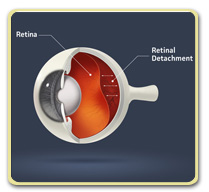The retina is the light-sensing layer of tissue that lines the back of the globe of the eye. Images that are focused onto the retina by the lens of the eye are sent to the brain via the optic nerve. In the most common type of retinal detachment, a tear or break in the retina allows fluid to get under the retina and separate it from the layer of blood vessels that provides oxygen and nourishment. A retinal detachment is so serious that it is considered to be a true medical emergency. The longer retinal detachment goes untreated, the greater the risk of permanent vision loss in the affected eye.
Risk factors. Retinal detachments are more common in people who:
- Are extremely nearsighted
- Have had a retinal detachment in the other eye
- Have a family history of retinal detachment
- Have had cataract surgery
- Have had a severe eye injury
- Take glaucoma medications that make the pupil small (like pilocarpine)
Cause of retinal detachment: The globe of the eye is filled with a clear gel called vitreous that is in direct contact with the retina. “Floaters”, the specks that float about in your field of vision, develop when this vitreous gel shrinks into more solid particles. With aging, or due to some of the factors mentioned above, the vitreous can sometimes shrink and pull hard enough on the retina to create a tear. Vitreous fluid entering the retinal tear separates it from the underlying layer of tissue resulting in a retinal detachment.
Symptoms of retinal detachment: When the retina becomes detached, it does not function normally and vision becomes blurry. Other symptoms of a retinal detachment include:
- A sudden increase in size and number of floaters
- The sudden appearance of flashes of light
- Development of a shadow in the visual field
- Seeing a gray curtain moving across the field of vision
- A sudden decrease in vision.
Treatment of retinal tears and detachments: In a retinal tear, a hole has formed in the retina, but fluid has not yet entered the tear to cause a detachment. When this is the case, the tear can be treated by sealing the retina to the back of the eye with laser surgery (photocoagulation) or a freezing treatment known as cryopexy. With laser surgery, small burns at the margins of the retinal tear scar down, sealing the tear and preventing detachment. By applying intense cold to the margins of the retinal tear, cryopexy produces a similar result to laser photocoagulation. Both of these procedures can generally be performed on an outpatient basis.
In addition to laser photocoagulation or cryopexy to treat the retinal tear, additional measures are necessary if the retina has become detached. Two of the most common surgical measures for retinal detachment are pneumatic retinopexy and placement of a scleral buckle. With pneumatic retinopexy, a gas bubble is injected into the vitreous which applies pressure to the area of the detachment. The scleral buckle is a synthetic band that is attached to the outside of the eyeball which pushes the eye against the retinal detachment. The idea behind both of these procedures is to apply enough pressure to remove the fluid that accumulated beneath the retinal tear and allow the retina to reattach to the underlying layer of tissue. Both of these procedures may require a hospitalization and a period of absolute rest while healing occurs.
Results of treatment: It cannot be overstated that a retinal detachment is a medical emergency and that medical attention should be sought with the first signs that this could be occurring. In the majority of cases, retinal detachment can be successfully treated, but treatment success if often related to how quickly treatment is initiated. Any of the symptoms mentioned—increasing floaters, flashes of light, sudden decrease in vision, etc. —warrants prompt medical evaluation to determine if this could be due to a retinal tear or detachment.
Sources for article:
Retinal Detachment from the National Eye Institute
Retinal detachment from Mayo Clinic
Retinal Detachment: What Is a Torn or Detached Retina? from the American Academy of Ophthalmology
If you have any questions about retinal detachment, please log into your account and send
us your question. We are here to help.
Kent Davidson MD – Health Tip
Content Editor
